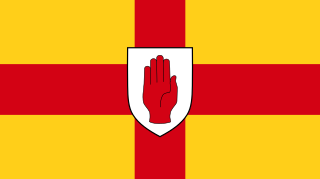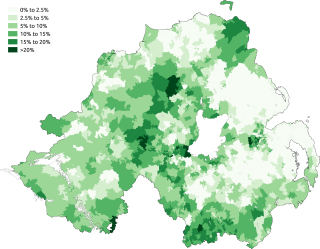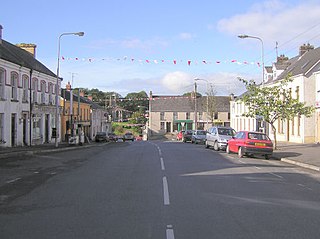
Ulster is one of the four traditional or historic Irish provinces. It is made up of nine counties: six of these constitute Northern Ireland ; the remaining three are in the Republic of Ireland.

County Tyrone is one of the six counties of Northern Ireland, one of the nine counties of Ulster and one of the thirty-two traditional counties of Ireland. Its county town is Omagh.

Omagh is the county town of County Tyrone, Northern Ireland. It is situated where the rivers Drumragh and Camowen meet to form the Strule. Northern Ireland's capital city, Belfast, is 68 miles (109.5 km) to the east of Omagh, and Derry is 34 miles (55 km) to the north.

Limavady is a market town in County Londonderry, Northern Ireland, with Binevenagh as a backdrop. Lying 17 miles (27 km) east of Derry and 14 miles (23 km) southwest of Coleraine, Limavady had a population of 11,279 people at the 2021 Census. In the 40 years between 1971 and 2011, Limavady's population nearly doubled. Limavady is within Causeway Coast and Glens Borough.

The Irish language is, since 2022, an official language in Northern Ireland. The main dialect spoken there is Ulster Irish. Protection for the Irish language in Northern Ireland stems largely from the European Charter for Regional or Minority Languages.

Irish literature is literature written in the Irish, Latin, English and Scots languages on the island of Ireland. The earliest recorded Irish writing dates from back in the 7th century and was produced by monks writing in both Latin and Early Irish, including religious texts, poetry and mythological tales. There is a large surviving body of Irish mythological writing, including tales such as The Táin and Mad King Sweeny.

The Plantation of Ulster was the organised colonisation (plantation) of Ulster – a province of Ireland – by people from Great Britain during the reign of King James VI and I. Most of the settlers came from southern Scotland and northern England; their culture differed from that of the native Irish. Small privately funded plantations by wealthy landowners began in 1606, while the official plantation began in 1609. Most of the land had been confiscated from the native Gaelic chiefs, several of whom had fled Ireland for mainland Europe in 1607 following the Nine Years' War against English rule. The official plantation comprised an estimated half a million acres (2,000 km2) of arable land in counties Armagh, Cavan, Fermanagh, Tyrone, Donegal, and Londonderry. Land in counties Antrim, Down, and Monaghan was privately colonised with the king's support.

Magherafelt is a town and civil parish in County Londonderry, Northern Ireland. It had a population of 9,071 at the 2021 Census. It is the biggest town in the south of the county and is the social, economic and political hub of the area. It is part of Mid-Ulster District.
The Rt Hon. and Reverend Robert Moore, PC, was a Northern Irish politician and Presbyterian minister.

Ulster English, also called Northern Hiberno-English or Northern Irish English, is the variety of English spoken mostly around the Irish province of Ulster and throughout Northern Ireland. The dialect has been influenced by the local Ulster dialect of the Scots language, brought over by Scottish settlers during the Plantation of Ulster and subsequent settlements throughout the 17th and 18th centuries. It also coexists alongside the Ulster dialect of the Irish (Gaelic) language.

Sixmilecross is a townland and small village in County Tyrone, Northern Ireland.

Tamlaght, also Tamlaght O'Crilly, is a small village, townland and civil parish in County Londonderry, Northern Ireland. In the 2001 Census it had a population of 123 people. It is situated within Mid-Ulster District.

Burt is a parish in County Donegal, Ireland, on the main road between Letterkenny and Derry.
Sir John Ross, 1st Baronet, PC (I), KC (1853–1935) was an Irish politician and judge who was the last person to hold the office of Lord Chancellor of Ireland.

That part of the United Kingdom called Northern Ireland was created in 1922, with the partition of the island of Ireland. The majority of the population of Northern Ireland wanted to remain within the United Kingdom. Most of these were the Protestant descendants of settlers from Great Britain.
Joseph Johnston was an Irish academic, farmer, writer and politician.
James Alexander Hamilton Irwin (1876–1954) was an Irish Presbyterian minister and a supporter of Irish unity and independence.
Lydia Mary Foster was an Irish writer and teacher, who wrote three books drawing on the experiences of growing up in rural Ulster in the 19th century in the Kailyard school genre.
William G. Wilson Guy was a creamery manager, author, poet and broadcaster from the Fintona area in County Tyrone, Northern Ireland. Much of the dialogue in his books, and many of his poems and short stories are written in the local Ulster English dialect.
The Rev. Robert Lyons Marshall, from Sixmilecross in County Tyrone, Ireland, was a Presbyterian minister, a writer and poet, and Professor of English and History at Magee College, Derry. He was the elder brother of William Forbes Marshall, the 'Bard of Tyrone'. His short stories in At Home in Tyrone and some of his poems were written in the local Ulster English dialect.













